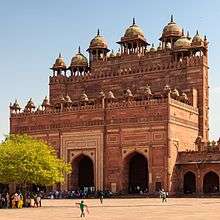Buland Darwaza


Buland Darwaza (Hindi: बुलंद दरवाज़ा, Urdu: بُلند دروازه,[1] pronounced [ˈbʊlənd̪ d̪ərˈʋaːzaː]), or the "Gate of Magnificence", was built in 1601 A.D. by Akbar to commemorate his victory over Gujarat. It is the main entrance to the palace at Fatehpur Sikri, a town which is 43 km from Agra, India.[2][3]
Buland Darwaza is the highest gateway in the world and is an example of Mughal architecture. It displays Akbar's empire.[4][5]
Architecture
The Buland Darwaza is made of red and buff sandstone, decorated by white and black marble and is higher than the courtyard of the mosque. The Buland Darwaza is symmetrical and is topped by large free standing kiosks, which are the chhatris. It also has at the top center, terrace edge gallery-kiosks on the roof, stylized buckler-battlements, small minar-spires, and inlay work with white and black marble. On the outside a long flight of steps sweeps down the hill giving the gateway additional height. It is 40 metres high and 50 metres from the ground. The total height of the structure is about 54 metres from the ground level. It is a 15-storied high gateway acting as the southern entrance of the city of Fatehpur Sikri. The approach to the gate consists of 42 steps.[6] It is semi octagonal in plan and two smaller triple-storeyed wings on either side. It has three kiosks on its top surrounded by thirteen smaller domed kiosks. There are smaller turrets surrounding the gateway.[4][5] The expanse is broken by arched niches, small chhatries and marble highlights. It highlights the courtyard of the Jama Masjid. The principal arch stands in the centre of three projecting sides and topped by a dome. The central arch is broken into three tiers with rows of smaller arches and flat brackets.[5]
The great gate itself is plain. The three horizontal panels of buff stone noticeable in Badshahi Darwaza are also present here. The plain red sandstone spandrels are framed in white marble with a flower like ornament inlaid in white marble at the apex of the arch, and a flattish rosette, centered with the narrow panel above it, on either side. The cusped ornament, large and bold in fact, but small and delicate when seen from below, is carried down below the springing of the arch. Two pieces have been broken off from the left hand side and eight from the right.The arch has three actual openings bordered by decorative panels and superimposed by three other arched openings crowned by a semi-dome.[4][5] The total height of the Gate above the pavement is 176 ft.
A Persian inscription on eastern archway of the Buland Darwaza records Akbar's conquest over Uttar Pradesh and the victory in Gujarat in 1601. An inscription on the central face of the Buland Darwaza describes Akbar's religious openness.
It took nearly 12 years to make the highest gateway.
Inscription
On the main gateway an Islamic inscription written in Persian reads "Isa (Jesus), son of Mary said: 'The world is a Bridge, pass over it, but build no houses upon it. He who hopes for a day, may hope for eternity; but the World endures but an hour. Spend it in prayer for the rest is unseen.'" Jesus was advising his followers not to consider the world as a permanent home.[6] Verses from the Quran have been carved in the Naskh (script) along the top. These were drawn by Khwaja Hussain Chishti, a disciple of Sheikh Salim Chishti.[5]
Purpose
Buland Darwaza was not a part of the original design of the Jama Masjid, it was erected by Akbar to celebrate his conquest of Gujarat in 1573.[5]
See also
- Taj Mahal
- Fatehpur Sikri
- Jama Masjid
- Tomb of Salim Chishti
- Ibadat Khana
- Mariam-uz-Zamani
- Naubat Khana
- Humayun's Tomb
Notes and references
- ↑ "Buland Darwaza" means 'high' or 'great' gate in Urdu.
- ↑ "Places to Visit in India: Buland Darwaza". India Travel. Archived from the original on 5 November 2014.
- ↑ There is another memorial gate called the "Buland Darwaza" at the Dargah Sharif in Ajmer, Rajasthan, "Historical Monuments". Mission Sarkar Gharib Nawaz. Archived from the original on 29 January 2015., and another in Hyderabad near the Golconda Fort.
- 1 2 3 http://www.agraindia.org.uk/fatehpur-sikri/monuments/buland-darwaza.html
- 1 2 3 4 5 6 http://www.culturalindia.net/monuments/buland-darwaza.html
- 1 2 "Buland Darwaza".
External links
| Wikimedia Commons has media related to Buland Darwaza. |
- http://www.bharatonline.com/uttar-pradesh/travel/fatehpur-sikri/buland-darwaza.html
- http://www.cruisingindia.com/document/uttar-pradesh/cities-in-uttar-pradesh/agra/things-to-do-in-agra/buland-darwaza-in-fatehpur-sikri-20060211090730/
- https://web.archive.org/web/20090125090104/http://www.tajhub.com:80/taj-mahal/monuments-india/fatehpur_sikri/architecture.html
- Gateway to the Mughal era, K D L Khan, Maharaja Features, Sunday 15 May 2011, Deccan Herald
Coordinates: 27°05′40″N 77°39′46″E / 27.09444°N 77.66278°E